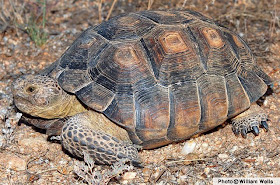Friday, June 17, 2011
Species of the Day: Desert Tortoise
Scientific Name: Gopherus agassizii
Family: Testudinidae
Adult Size: 10 to 14 inches long, 8 to 10 pounds
Range: Mojave and Sonoran deserts of southern California, southern Navada and Arizona with some isolated populations in Mexico.
Habitat: Inhabits areas occupied by creosote bushes, yucca trees and grasslands associated with alluvial plains. The Sonoran populations can be found on the slopes of rocky washes.
The Desert Tortoise is native to the Mojave desert and Sonoran desert of the southwestern United States and northwestern Mexico. Their shells are high-domed and are a greenish-tan to dark brown in color. Males are generally larger than females. In years past it was a relatively common practice to pick up a desert tortoise when they were found because of their docile nature. Due to education and conservation, this has slowed down considerably. Even so, it is still suspected that there are more Desert Tortoises in captivity than there are in the wild. They are now protected throughout their ranges and are listed at threatened. It is a federal offense to take them over state lines or take them from the wild. They are also not allowed to be sold or traded, but can be adopted through various rescue groups. The Desert Tortoise always does best when housed in a large, secure enclosure outdoors. Despite being very adaptable, they do not tolerate the cold and damp. If given free range of a well-planted backyard or enclosure, the require minimal care. Desert Tortoises should be maintained almost exclusively on grasses and weeds. It is important to mix in variety so the diet can be supplemented with dark leafy greens and vegetables, and fruit only on occasion. Desert Tortoises are strictly herbivores; they should not be given any animal protein in any shape or form. Even though this is a desert dwelling animal, water should still be available at all times.

No comments:
Post a Comment